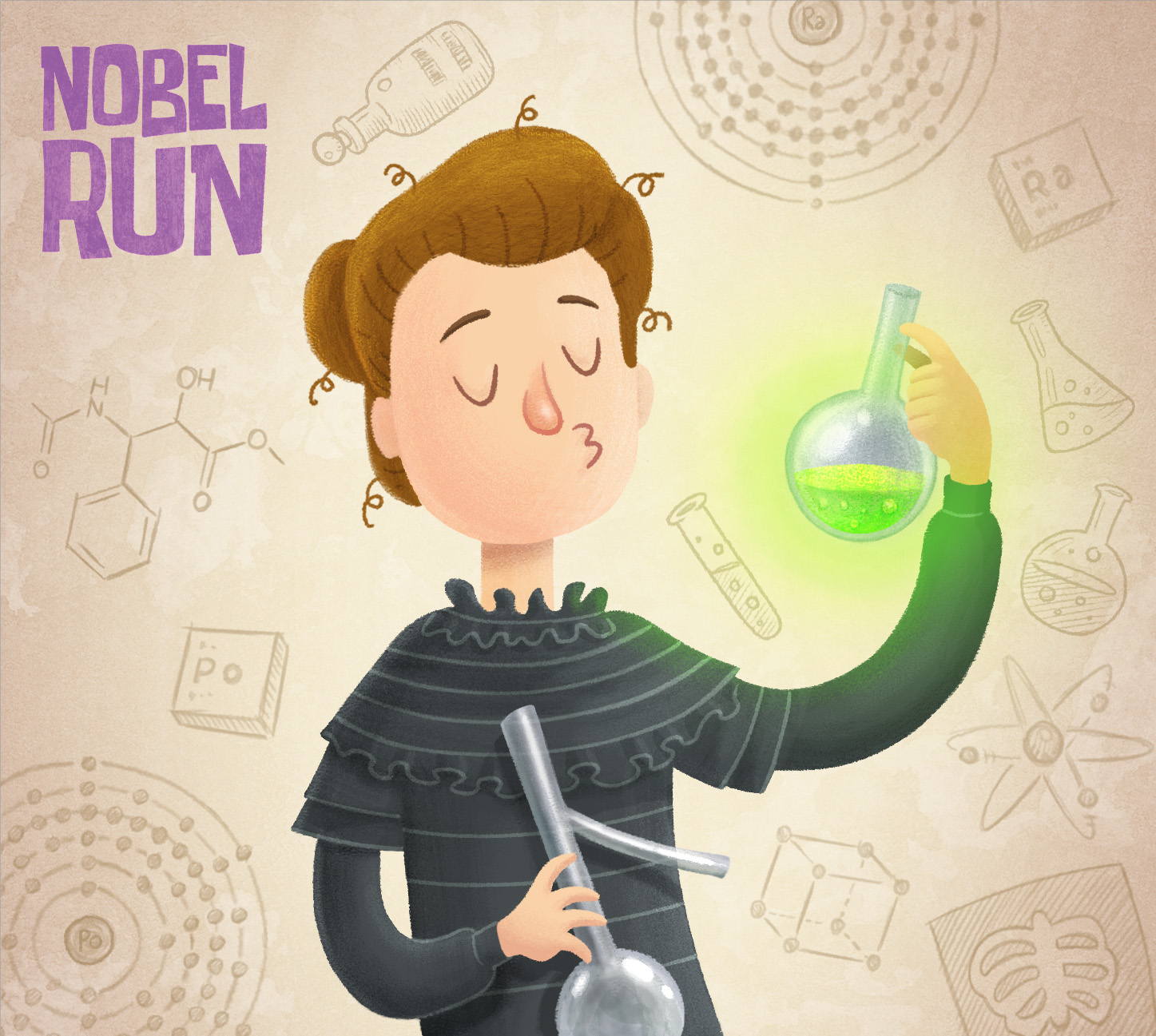
21 Dec Marie Skłodowska-Curie – Nobel Run Stories

“Be less curious about people and more curious about ideas.”
Marie Skłodowska-Curie
(Warsaw, 7 November 1867 – Passy, 4 July 1934)
A pioneer in the field of radioactivity, she was the first woman to win a Nobel Prize and the first person to receive two in different categories (Physics and Chemistry). She discovered polonium and radium with her husband, Pierre Curie. Despite these accomplishments, she suffered from the Matilda effect, as the first Nobel had been awarded only to her husband, Pierre. However, Pierre stood up to the Academy and told them that either they would grant the award to both of them or to neither. In 1906, after the death of her husband, she took up her professorship at the Sorbonne, becoming the first female lecturer there. However, in 1911 she was denied a seat at the French Academy of Sciences because she was a woman, a foreigner, a widow and in a relationship with a married man.
Awakening a passion for science
Maria Salomea Skłodowska-Curie was born in Warsaw in 1867, into a family that had lost all its possessions during the Polish nationalist uprisings. Leading her to have a harsh and restricted childhood. Maria inherited her passion for mathematics and physics from her father, Władysław Skłodowski, who was a professor of mathematics and physics.
At the time, women were not allowed to enrol in higher education, so she entered the clandestine ‘floating university’, a Polish patriotic institution that admitted female students. At the end of 1891 she went to Paris to continue her studies in physics, science, chemistry and mathematics, this time at the Sorbonne, where out of the 776 students in the Faculty of Science, only 27 were women. She studied during the day and taught at night for very little money, surviving on tea, bread and butter.
In 1893 she received her degree in physics and began working in an industrial laboratory, but continued to study at the University of Paris, where she obtained a second degree in 1894. That same year she met Pierre Curie. Their love of science brought their lives together, and they married just a year later. At her wedding she wore her navy blue laboratory attire, instead of a white wedding dress.
“It would be a fine thing, in which I hardly dare believe to pass our lives near each other hypnotized by our dreams, your patriotic dream, our humanitarian dream, and our scientific dream.”
Letter from Pierre Curie to Maria Skłodowska.
Radioactivity
Her next challenge was to obtain a doctorate, so she began research on radioactive substances. The Curies had no laboratory of their own and most of their work was carried out in a poorly ventilated and permeable shed. They were not yet aware of the harmful effects their work was having on them due to the constant exposure to radiation.
In July 1898, the couple announced the existence of an element they named polonium, after Marie Skłodowska’s homeland. Months later, on 26 December of the same year, they published the existence of a second element, which they called radium, derived from a Latin word meaning lightning. Their research led to the word radioactivity.
In 1902, they obtained the first gram of radium after processing 8 tonnes of the mineral known as pitchblende. In 1910, they succeeded in isolating radium in its pure state and discovered that when humans are exposed to radium, diseased and tumour-forming cells are destroyed faster than healthy ones.
On 25 June 1903, Marie Curie managed to successfully defend her doctoral thesis, supervised by Becquerel, cum laude. That month, the Curies were invited by the Royal Institution of Great Britain to give a speech on radioactivity, but only Pierre was allowed to because she was a woman.
Radium became a very profitable business, but as the Curies had not patented their discovery, they made little financial gain. Their unusual but intentional decision allowed the scientific community to research it without hindrance. During this time, the Curies also began to suffer the first health complications from their continued exposure to radioactivity.
The Nobel Prize
In 1903, she was awarded the Nobel Prize for Physics alongisde her husband and Henri Becquerel, making her the first woman to win the prize. But it was not easy, as the selection committee had initially refused to recognise her. One of the members of the Academy, the mathematician Magnus Gösta Mittag-Leffler, alerted Pierre to the situation and he said he would refuse the prize if Marie’s work was not recognised. This led her to be included in the nomination.
On 19 April 1906, Pierre died in an accident in Paris. While walking in the pouring rain, he was struck by a horse-drawn carriage and fell under the wheels, resulting in a fatal skull fracture. In the following years after his death, Marie suffered from depression.
On 13 May 1906, the Physics Department of the University of Paris decided to offer her the teaching post that had been created for her husband. She accepted in the hope of creating a world-class laboratory as a tribute to her husband. This post made her the first woman professor at the Sorbonne and the first director of a Sorbonne laboratory. She gave the inaugural lecture to a hall full of students and onlookers.
However, in 1911 she was denied a seat at the French Academy of Sciences because she was a woman, a foreigner, an atheist, a widow and in a relationship with a married man. She became embroiled in a journalistic scandal because the press revealed that, after her husband’s death, she had had a brief affair with the physicist Paul Langevin, a former student of Pierre’s, who was married. The tabloids labeled her a “foreign Jewish home wrecker”. When the scandal started, she was at a conference in Belgium. On her return, she found an angry mob outside her home and had to take refuge with her daughters at a friend’s house. More than half a century later, in 1962, Marguerite Perey, who discovered francium, was the first woman to be elected as a member of the French Academy of Sciences. On Perey’s first day in the lab, a very kind lady approached her. Marguerite thought it was the secretary, but it was none other than Marie Curie.
In 1911, she was awarded the second Nobel Prize in Chemistry, becoming the first person to receive two in different categories (Physics and Chemistry). This prize was “in recognition of her services to the advancement of chemistry by the discovery of the elements radium and polonium, by the isolation of radium and the study of the nature and compounds of this remarkable element”. But she was not free from controversy, as the Royal Swedish Academy of Sciences wrote to persuade her not to go to Stockholm to receive it because an “adulteress should not shake hands with the Swedish king”. To which Marie replied: “The prize has been awarded for the discovery of radium and polonium. I believe that there is no connection between my scientific work and the facts of private life”.
Years later, the curium, a radioactivity unit, was named after her and her husband. Although the commission that decided on the name never clearly stated whether they did so in honour of Pierre, Marie or both.
World War I
During the war, field hospitals lacked experienced staff and proper X-ray machines, so Marie invented mobile radiology units, which she called “radiological ambulances” (although everyone knew them as petit Curie), to assist battlefield surgeons, saving thousands of lives on the front line.
Assisted from the outset by her daughter Irène, then aged 18, and a military doctor, she directed the installation of twenty mobile X-ray units and two hundred other radiological units in the temporary hospitals. Later, she began to train other women as assistants. In July 1916, she was one of the first women to obtain a driving licence to personally operate mobile X-ray units.
Her legacy
She died on 4 July 1934 of aplastic anaemia, probably contracted from prolonged exposure to radiation, the effects of which were unknown at the time. In fact, it was common for her to carry test tubes containing radioactive isotopes in her pockets. Because of this, her work is still kept today in lead-lined boxes.
In 1995 her remains were transferred, together with those of Pierre, to the Panthéon in Paris. There her tomb is also lined with lead to protect against radiation. Albert Einstein, a close friend of our heroine, commented that Marie Curie was probably “the only scientist who was not corrupted by fame”. Her great scientific contributions continue to save lives.
Marie Skłodowska-Curie is one of the scientists who appears in our board game Nobel Run. More info: Gearing Roles launches the Nobel Run board game to give visibility to women in science.
Text by Lorena Fernández (@loretahur).
Illustrations by Iñigo Maestro (@iMaestroArt).



Sorry, the comment form is closed at this time.